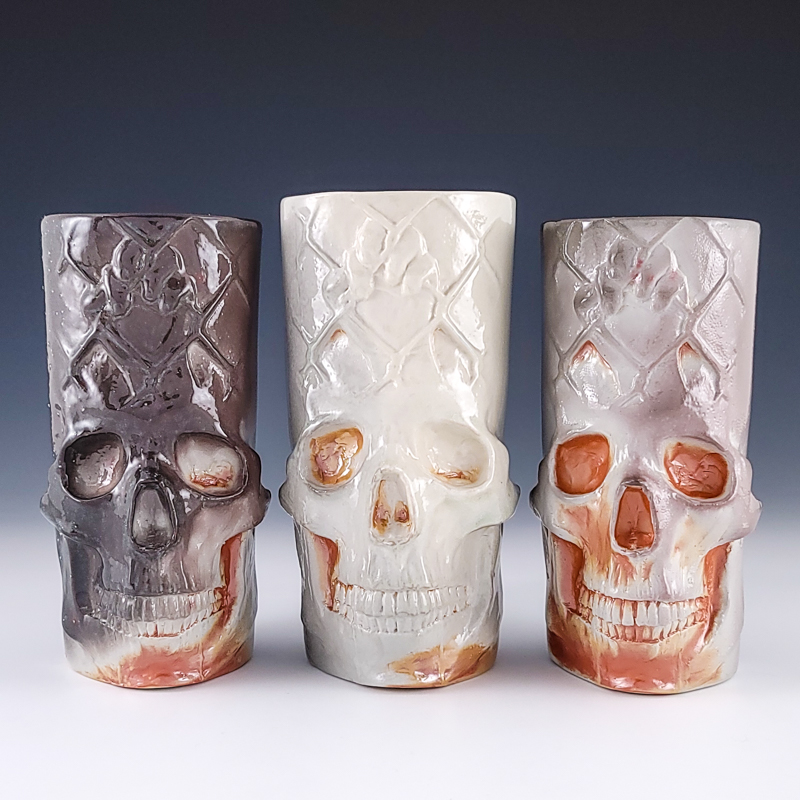My work is about Mexican labor and the plight, struggle, hope, and heritage of Mexican immigrants. With political administrations that continue to enforce policies that dehumanize and force immigrants into the shadows, recognizing an immigrant’s humanity is vital. As the son of immigrant parents, I hope to pay homage to my people and the dignity of their labor. This exhibition, Immigrant Narratives, focuses on the stories of undocumented immigrants along the US-Mexico border.
I see the water jug as a symbol of the dangerous journey across the desert. I grew up hearing stories of family friends that died in the desert before making it to the US. The water jug form was also my response to a video of an ICE officer dumping out water jugs that had been left behind by a humanitarian group. The water bottles had been left behind to prevent deaths from dehydration, and to see this man essentially condemning people to death with a smile on his face showed me what can happen when human beings are separated by an “us” and “them” mentality.
The water jug form references the journey, and the hand-painted images on them depict some of the consequences undocumented immigrants face when the search for a better life is unsuccessful. The image of a child’s hand behind a chain link fence references the harsh living conditions for undocumented children in detention facilities at the border, including dehydration and more than 4000 allegations of sexual abuse in the last 5 years. This image is painful to paint, but I hope that when people see it, it can spark much needed conversations on human dignity.
I have included a limited series of iron decal mugs with images of the ICE officer that was recorded dumping out water, a caged child, and a monarch butterfly. These images were turned into decals from photographs of two large-scale graphite drawings I drew during a short-term residency at Companion Gallery. Because of its migration between the US and Mexico, I see the monarch butterfly as a symbol for the immigrant. The inclusion of the concertina razor wire reminds me of the photographs I saw of a mother and her child severely cut from the wire in an attempt to cross the border wall. In those images I saw an example of the price people are willing to pay for a chance at the American dream and a chance to provide a decent meal for their families. I made this series in an attempt to have both a more affordable tier of work and more pieces with these images out in the world. If I had hand-painted these images on each mug, the price would be higher than $350 just to get above minimum wage and this show would have taken all year to complete. Using a hand-drawn reference, different colors, and different image placement felt like a great way to still make unique pieces with a significant message.
Before my parents became legal residents, I spent my childhood in Mexico waiting for my mother to get her green card. She sewed clothes, repaired clothes, washed clothes, and sold clothes so my sister and I could eat. We would ride around on bicycles to collect small payments because the people of San Miguel Octopan, Gunajuato could not afford to pay full price. The pitcher forms I have in this show are made from molds of detergent bottles. It was a way to honor my mother and everything she did for my family. The happier images on these pitchers have become a way for me to cope with the political work that takes an emotional toll over time.
For the hand-painted images I use a small watercolor brush and paint my images with Amaco’s black underglaze on functional vessels. I use a pointillism technique because the process is time-consuming and labor intensive. The process, with time invested, becomes an act of devotion.
After the imagery is painted on bisqueware, I bisque again to set the image and avoid smearing the underglaze. I protect the images with liquid latex and airbrush a clear glaze on the rest of the piece. I make the work permanent and functional by firing to cone 10 in an electric kiln. – Juan Barroso

